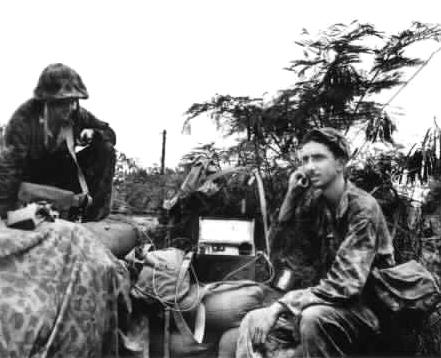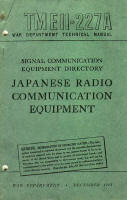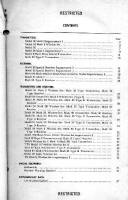|
Home
::
|
WWII Japanese Radios Introduction
|
 |
Introduction The main purpose of this article is to provide radio collectors with a basic knowledge of the subject and to get them started in collecting Japanese Radios if they were so inclined. It is not designed as a replacement for the more comprehensive book, "Collecting WW II Japanese Communication Equipment" which has over 67 pages of technical information and many colour photographs. The basic radios that can be found are the Type 94-6, a small one tube transceiver (Two tubes in one glass envelope) and the Type 94-5 set which consists of a small one tube transmitter and a separate three tube receiver. These are very small radios and would fit inside a duffel bag with ease. They are the company and battalion level sets. See Electric Radio articles by Ken Lakin. They are powered by small hand cranked generators when transmitting and by batteries when receiving. There are a lot of accessories that go with these. I have available a cost breakdown on these sets which lists most of the accessories, if anyone is interested.
|
The Type 94-3A sets were used by the Division and Regimental stations and are rare items, there being three sets that I know of in private collections. Two in the US and one in England. There are also a Type 94-3B and a Type 94-3C set . Very little is known of the 94-3 B set. The Type 94-3C sets were used by the horse cavalry units and while rare are in existence in private collections. Consisting of a Receiver, transmitter and hand cranked generator. They used plug in coils as did the Type 94-3A set. I have seen ads for the receivers in ARC and elsewhere. Transmitters are much rarer, as are the generators. The Type 94-3D set seems to be a companion receiver for the Type 94-3A set.
Any other Army or ground forces set is extremely rare and they seldom show up. Aircraft radios are also rare but they do turn up. With out the case they are worth about $75 to $150 With the case, more. A type 99-5 receiver in the case was found in a New Jersey flea market for $250.00 a few years ago.
Japanese Army Aircraft radios that are most commonly found were designated as Type 99-1, 99-2. 99-3, 99-4 , and 99-5. Made up of the receiver, transmitter, dynamotors and control boxes, they are seldom found in complete condition. Difficult to work on, hard to find schematics for them and of limited appeal to HAM radio operators, these were not brought home in any great numbers. They range in value from one station that was complete, with control boxes, dynamotors and cabling for $65.00 to one set consisting of receiver and transmitter only for $1,200 dollars. If you like aircraft radios, these are very good examples of enemy aircraft radios.
Japanese Naval aircraft radios are also scarce items as most of them went down at sea when the plane crashed. Those that survived crashing at sea , crashed on land. Sometimes these sets were captured when an airfield was over run by allied forces. These too have limited appeal to HAM radio operators, were hard to work on, had hard if not impossible to find schematics and were not brought home in any large numbers. While rare items, the are not as valuable as some of the army ground radios.
For anyone who is planning on collecting these sets or restoring them to an operational status, they should first get several important reference works.
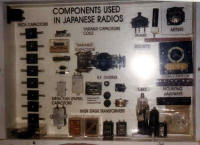 Japanese Components Display |
 |
Basic Reference Works The basic reference book is a copy of the WW II TME11-227 A Japanese Radio Communication Equipment, issued in Dec 1944 by the war Department. This covers all the radios that had been captured and reported on that allied troops were likely to encounter. It shows a picture of the radio and sometimes the complete station. It also provides some details on the set and from the picture and the tube line-up you can usually determine what you have got. There is a British equivalent to the above series TMs. Part A covers German radios, Part B covers Italian and Part C covers Japanese sets. These do not give as much detail as the US TM but they do have a section that explains how to translate data plates, control marking and other Japanese radio terms. This is very useful and most collectors have a copy. The entire series cost $70.00 and is not worth it. TM30-485 was another technical manual put out by the War Department in May of 1943. Titled: Japanese - English Glossary Technical Communications Terms. This is difficult to read or use unless you know Japanese . If you find a copy, pick it up. You will find it is useful as you gain experience in translating Japanese. If you can find a local Japanese translator, this will ease his/her task considerably. |
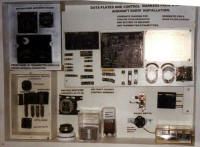 Japanese Components Display |
Most of the more commonly encountered radios, that could be utilised by U.S. personnel became the subject of a technical bulletin. These TB s are a must have item if you are going to work on a set. Until recently, there were two of these TBs floating around and copies usually are sold for about $20 to $25 dollars. More of these have been located and are now also available.
Articles on the Type 94-5 Station and the Type 94-6 set have been written and have been articles published. Dick Rollema wrote an article on the Type 94-6 and Ken Lakin has written two articles on the Type 94-5 transmitter and the receiver. He has both sets operational. Ken's receiver was a major restoration case but he did it and it came out very well.
Where to find these sets?
A few years ago this would have been an easy question to answer. At Radio swap meets. In
the last ten or more years this question has got harder to answer. In 1989, we began the
50th Anniversary of WW II and there was a sudden revival of interest in items of WW II.
Old radios came out of attics , closets and basements.
In 1988, we had a surplus electronic store that made a living selling parts stripped from surplus radios and took stuff in on consignment. One day the owner called me and said he had two Japanese radios, was I interested. To make a long story short, I got these two radios for $100.00 each, which at the time, I thought was a bit high but I wanted them. What I got was a Type 94-5 receiver with the leather flaps cut off and a Type 94-3 receiver missing the front cover, a fact I was ignorant of at the time.
Since then, I have got Japanese radios from a variety of sources. I will list the more lucrative sources.
The local ferret.
He went to every estate sale, yard sale and HAM Swap meet he heard about. His ability to
ferret out radios of all types was amazing. He didn't know what they were but if they were
Japanese he got them and thus I got them. His main interest was pre 1925 battery powered
sets. I also kept my eyes open for them but never found anything he wanted.
The local Japanese Militaria dealer.
This man is retired and currently runs a business of importing Japanese artefacts. He has
a large following and publishes a news letter for Japanese collectors. He sets up at
militaria shows and gun shows. He has material coming in from all over and I usually get
first crack at a new item.
Radio related surplus stores.
Sometimes these places take things in on consignment, Get to know them, let them know your
interests and when a Japanese whatever comes in, they will call you. Usually, they advise
the owner on the value of the set from the perspective of a radio. Usually low as they do
not know the collector value, however, you can not count on that. Some people find a
Japanese or German radio in their attic and think they have their fortune made, "It
Isn't So!"
Japanese Militaria Collectors.
Many of these people specialise in some aspect of Japanese militaria such as hats or
swords or daggers. In the process they pick odd pieces and will usually part with them for
a reasonable price. Find out who these people are, get to know them and also stay on the
look out for what they are interested in.
Other radio collectors.
Finding these people is not always the easiest task unless you are a HAM radio operator.
The older HAMs are the ones who brought back these radios from their days in WW II. As
time passed, they became more successful and had more money, they got better and newer
radios and the Japanese radios went to the closet, the attic, etc. The main means for
communication, other than radio, were the HAM trader yellow sheets. In more recent times,
magazines like the Old Timers Bulletin of the AWA, Electric Radio, and others have carried
ads for Japanese radios , both for sale and for trade as well as wanted. Once you have
established a network of radio collectors, they watch for things you are interested in and
you may get lucky.
HAMFESTs and Swap meets.
Which are always a good place to find radios and radio related items is still a good place
to go. I have noticed in recent years that most of the exotic German and Japanese sets are
sold long before they get to the show but again you might get lucky.
Flea Markets and gun shows.
You never know what will show up at a flea market, You have to check them out and keep
going back, week after week. Take cash as these people never heard of credit cards and
won't take checks. Gun shows are much the same. In the 30 plus years I have been going to
gun shows, I have never seen very much radio equipment. You can find keys, headphones,
coils and other miscellaneous items. It is rare for someone to have radios at a gun show.
The militaria shows are a better choice and then most people do not know very much about
Japanese radios so they are usually cheaper.
Manion's Auction.
Some years back this outfit started taking in items for auction. They have a subscription
service. You pay about $35.00 a year and you are able to bid on items in each auction.
They have about 5 or 6 auctions per year. They publish a catalogue and some times have
excellent photos of the items shown. Their ability to determine what an item is and
accurately describe it is sometimes questionable. An experimental Japanese Walkie Talkie
was advertised as a telephone. Some times it is just cord and plug with Japanese markings.
Whatever the item is worth and or sold for, they add on a percent commission which the
buyer pays as well as tax and shipping. The $75 dollar bargain quickly becomes a $100+
item.
Increasingly the inter net and radio collectors groups are proving to be a good source for these items. I recently got two Japanese radios from a collector in Colorado who told me about a supply of Japanese crystals in a local surplus store. Through his efforts, I got the crystals. I would never have known about him or the crystals were it not for a radio collecting group of which I am a member. In the same way, I was able to help a collector in Maryland get field telephones and a switchboard from a local shop that he would never have know about.
The eBay internet auction.
This has been the source for Japanese Radios that are coming out of closets. During 1998
ad into 1999 this auction has seen many Japanese radios appear. Some common and some rare
sets. In most cases the prices are very high and bidding, done via the internet becomes
very intense at the last moments. You have to watch the clock and make a very high bid at
the last possible moment, usually seconds before the auction closes.
Small picture ad in the local newspaper. or if you spend your vacation in one area, consider taking out an ad in the local paper. Make it big enough for people to see. Best to include a line drawing of a Japanese radio, some people who have these items do not even know what it is. They may see the drawing and think, "I've got something like that in the basement". In summary, there are many places where these radios and accessories are to be found. It is advisable to have some of the references I mentioned in Part 2 when you get there.
The most widely issued Japanese radios were issued in two or more wooden transport chests. These chests had a removable front panel which had a contents list inside under a plastic cover. The chests had leather covered rope handles at each end and may have had a metal carry handle on the top. Usually these chests are found with out the rope handles and if the rope is present, the leather is missing having rotted off many years ago.
Back to Collection of Japanese W.W.II Radios
Army Radio Sales Co. Home Page.

